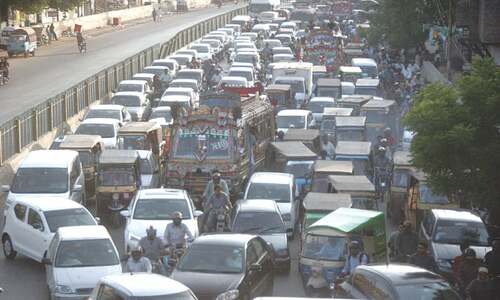It's the breeze. Cool as a moment of bliss and refreshing like a thought full of hope. It blows from the west and if you're at the fag end of Bunder Road facing St George's Church, it will greet you with a thirst-quenching spirit, and may make your hair look dishevelled. Don't be surprised if it starts talking to you: “I'm Karachi's gentle wind, befriend me.” It sounds loony. That's the kind of magic that Keamari can conjure.
The whole area is a minefield packed with history. There's a colony made for customs officers lined with beautiful stone-made bungalows; there are breathtaking churches; there's an old dockside; there's a colonial clock tower and numerous other such vestiges of a period when time was both lover and beloved, when diversity was accepted in all manifestations. While some of these places are not known to many Karachiites, there's a market in the Keamari area that was famous in the past for its cheap-as-chips goods. (It is still a fairly bustling bazaar.) It was known as Jackson Market.
Before you reach Jackson Bazaar, as it is referred to nowadays, the journey from Native Jetty Bridge to Jackson Market is a simple yet exhilarating one. There's no other sight in the city like this one on either side of Bunder Road. The ships anchored at the harbour, the official as well as residential structures made of stone, the birds dotting the sky and the breeze, yes, the breeze, unadulterated temperate wind. You move in a linear direction and keep looking left. After a few shabbily maintained bits of stonemasonry you'll see Central Fire Station. Keep moving.
Move ahead and you'll get to view some new constructions and then see a rather small and nice building, which is a workplace related to the shipping industry. Some yards away is the magnificent Mules Mansion and just before you reach a Sufi saint's mazar, turn left in the not-so-narrow lanes to enter the world of Jackson Market.
In modern-day Karachi this bazaar has lost its pristine touch. New concrete buildings have sprung up. New shops have emerged. New shopkeepers occupy the area. Not too many aged structures can now be chanced upon in the market (though this can't be said about other parts of Keamari). If you enter the bazaar from the street just before the above-mentioned shrine, after a few blocks you'll see a work of construction with unique-looking quadrangular and rectilinear windows which doesn't commensurate with the blocks preceding or following it. No one knows what it was originally called nor is anything written, inscribed or embossed on its walls that indicates its date of construction and maiden name. (One man working at a bank will tell you it's called Masoomal Building.) What can't be argued is that it's a building built before partition.
A little ahead at the corner of the street is a residential structure with shops on the ground floor. It is indisputably a piece of stonemasonry. Again, no names are mentioned anywhere, but the locals know it as Khushi Ram Building. This gives you the idea that the neighbourhood in its early days was inhabited by the Hindu community.
Now walk across the lane from where Khushi Ram Building stands, because here lie two examples of vintage colonial architecture. Look to your left and there's an edifice which will grab your attention. It is Baveja Building made in 1936. The piece is not a well-maintained one and additions have been made to it. Still, it's a nice reminder of peaceful yesteryear.
Turn right and a couple blocks ahead there's another such structure called Banoo Manzil. The date of construction written next to its name is 1930. So it's six years older to its stone sibling and is also in need of restoration.
Architect Noman Ahmed says: “Keamari's architecture, that is Jackson Market and its adjoining areas, has functional type of constructional attributes which adjusted themselves according to the evolving requirements of the time. Initially this zone was developed by a number of Hindu businessmen and merchant navy entrepreneurs. The record that we have suggests it was after 1839 that a majority of developments was supervised by the British.
“You've mentioned Baveja Building. According to some documents, it was made in the 19th century, and later on additions were made to it. It was a public residence whose most interesting feature is the balconies. Then there used to be a Hindu dharmashala in the neighbourhood; it is now under the Auqaf department.”
“I don't exactly know which Jackson the market was named after. What I can tell you is, there was a certain Dr Jackson who ran a popular dispensary where he worked as a Christian missionary doctor treating patients for free,” says Mr Ahmed.There was a certain Dr J. Jackson who was principal of the DJ College (1888-1907). Was the bazaar named after him? Probably. Probably not.
When you try and return from Keamari, it's not just the old surroundings that make you revisit the area, but also the breeze...
mohammad.salman@dawn.com















































Dear visitor, the comments section is undergoing an overhaul and will return soon.